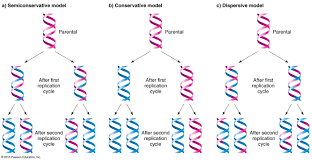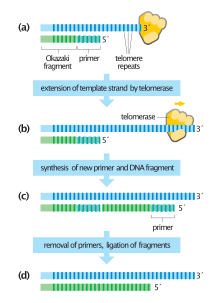-

Genetic Code Overview
Here’s an excerpt from the provided text on the Genetic Code: The **Genetic Code** is a universal set of rules essential for translating genetic information into functional proteins. It operates on a **triplet code** system, where each **codon**, composed of three nucleotides, corresponds to a specific amino acid. This code is **non-overlapping** and **degenerate**, meaning…
-

DNA and its types
DNA, or deoxyribonucleic acid, is the genetic material that carries instructions for all living organisms. It comes in various types, including the double helix, single-stranded DNA, and RNA. DNA can have different conformations and can be supercoiled. Understanding these types is essential for DNA sequencing, genetic engineering, drug development, and forensic science.
-

Chromosome : Function
Delve into the intricate realm of chromosomes and their specialized nucleotide sequences, which are fundamental to essential cellular processes like DNA replication and chromosome segregation. The cell cycle, where these genetic elements take center stage, involves replication during interphase, forming sister chromatids, and their condensation into visible mitotic chromosomes. Three guardian sequences orchestrate this process:…
-

The Steps of Next-Generation Sequencing
Introduction: Steps: Sample Preparation: Library Preparation: Sequencing: Data Analysis: Conclusion:
-

Structure of DNA
I. Introduction II. Chemical Composition III. Double Helix Structure IV. Chromosomes V. Replication VI. Conclusion
-

DNA Replication: Three Alternative Models
Introduction: DNA replication is the process by which a cell copies its DNA before cell division. It is a critical process that ensures the accurate transmission of genetic information from one generation of cells to the next. There are three main models of DNA replication: semi-conservative replication, conservative replication, and dispersive replication. Semi-Conservative Replication: Conservative…
-

Telomere Replication
Introduction: Functions of Telomeres: Telomere Replication: Extension: Replication: Factors Influencing Telomere Replication: Conclusion:
-
Mendel’s Laws of Inheritance
Gregor Mendel’s groundbreaking research on pea plants led to the formulation of two fundamental laws of inheritance. The Law of Dominance explains how dominant and recessive traits are inherited, while the Law of Segregation elucidates the separation of alleles during meiosis. The Law of Independent Assortment further reveals the independent inheritance of different traits. These…
-
Exons and Introns
Dive into the intricate world of gene transcription with a focus on exons and introns. Explore how eukaryotic genes differ from prokaryotic ones and uncover the roles of exons, coding sequences, and introns, non-coding segments, in shaping gene expression. Delve into the structure of the human β-globin gene as a case study, unraveling its various…
-
Sex Determination in Drosophila
Drosophila, commonly known as fruit flies, have long been a staple in genetic and developmental biology research. One of the most fascinating aspects of Drosophila biology is their sex determination process, intricately tied to their genetic makeup. The sex of these tiny organisms is dictated by a single pair of sex chromosomes, X and Y.…
-

Secondary Sex Determination in Mammals
Explore the intricate realm of secondary sex determination in mammals, where hormones and genetic interplay shape diverse phenotypes. Uncover the two major phases and hormonal cues guiding the development of sexual characteristics. From internal and external genitalia to reproductive ducts, delve into the journey of female and male phenotypes. Discover conditions like pseudohermaphroditism and true…
-

Chromosomal Sex Determination in Drosophila
Discover the unique chromosomal sex determination in Drosophila, where the intricate interplay of genes and chromosomes orchestrates sex. Dive into the captivating journey of how the X chromosome, Sex-lethal gene, and a cascade of molecular events shape sex-specific traits. Uncover the pivotal roles of transformer, doublesex gene, and transcription factors in steering the course of…
-

Attenuation in TRP Operon
Attenuation is a sophisticated gene regulation mechanism found in the TRP operon, responsible for tryptophan synthesis in bacteria. By utilizing the leader peptide and tryptophan as key players, attenuation allows precise control of gene expression based on tryptophan levels. The leader peptide acts as a sensor, adjusting the secondary structure to either block or allow…
-

Trp Operon
The Trp operon is a genetic regulatory system in bacteria that controls the production of enzymes for tryptophan synthesis. It consists of a promoter, operator, and structural gene region. Induction and repression mechanisms regulate transcription based on tryptophan levels. Feedback inhibition further modulates the operon. Understanding the Trp operon sheds light on genetic regulation, cell…
-

Gene Therapy: A study note
Gene therapy is a groundbreaking medical approach that holds tremendous potential for revolutionizing disease treatment. By altering the genetic material within cells, gene therapy aims to correct abnormal genes or introduce therapeutic genes to combat a wide range of conditions. This study note provides a comprehensive overview of gene therapy, exploring its principles, techniques, applications,…
-

DNA Microarray Technique
DNA microarray is a powerful technique used to study gene expression levels in a high-throughput manner. It involves hybridizing labeled target sequences to DNA probes on a microarray, allowing researchers to detect and quantify specific nucleic acid sequences. This study note explores the principles, procedure, applications, and limitations of DNA microarray, highlighting its role in…
-

Gel Electrophoresis
Gel electrophoresis is a widely used technique in molecular biology for separating and analyzing DNA, RNA, and proteins. It plays a crucial role in various applications such as DNA analysis, protein characterization, and clinical diagnostics. This study note provides an in-depth understanding of the principles, procedure, and applications of gel electrophoresis, making it a valuable…
-

ChIP (Chromatin Immunoprecipitation)
ChIP (Chromatin Immunoprecipitation) is a powerful molecular biology technique used to study protein-DNA interactions in cells. This article explores the principles, procedure, applications, and limitations of ChIP, providing insights into its significance in gene expression regulation and chromatin structure. Discover how ChIP has revolutionized research in genetics, epigenetics, and cancer research, while also exploring newer…
-

Pedigree Analysis
Pedigree analysis is a powerful method used in genetics to unravel the inheritance patterns of specific traits and disorders within families. By constructing a detailed family tree, known as a pedigree, and carefully studying the presence or absence of a trait in each individual, researchers can deduce whether a trait is inherited dominantly, recessively, or…
-

Lac Operon- Gene Regulation in Bacteria
The lac operon, found in E. coli bacteria, is a remarkable genetic system that controls the metabolism of lactose, a sugar commonly present in milk. This operon comprises three crucial structural genes: lacZ, lacY, and lacA, responsible for encoding the essential enzymes needed to break down lactose into glucose and galactose. Its significance in the…
-

RFLP (Restriction Fragment Length Polymorphism)
The excerpt introduces RFLP, a molecular biology method for detecting DNA sequence variations. It explains the principle of restriction enzymes cutting specific DNA sequences and generating restriction fragments. The procedure involves DNA isolation, digestion, gel electrophoresis, and hybridization with labeled probes. RFLP’s applications span genetics, forensic science, and medical diagnostics. Despite its replacement by newer…
-

Cell Cycle and Its Regulation
The cell cycle is a fundamental process that is essential for the growth, development, and maintenance of all living organisms. It is a series of events that a cell undergoes to replicate and divide into two daughter cells. The cell cycle can be divided into two main stages: interphase and mitosis. Interphase is the period…
-

Mitosis: Cell Division
Mitosis cell division is essential for the growth and repair of an organism. Mitosis involves four main stages: prophase, metaphase, anaphase, and telophase, followed by cytokinesis, the final stage where the cell physically divides into two identical daughter cells. The proper execution of mitosis is critical for the accurate replication and segregation of DNA and…
-

Meiosis: Cell Division
The text explains the process of meiosis, which is a type of cell division that produces reproductive cells or gametes. Meiosis reduces the chromosome number by half and is divided into two rounds of cell division: meiosis I and meiosis II. In meiosis I, the chromosomes pair up with their homologous partner, exchange genetic material…
-

DNA Footprinting
The DNA footprinting technique is used to study the interactions between DNA and proteins. This allows researchers to identify which regions of DNA are bound by specific proteins and how they interact with DNA. DNA footprinting has various methods like chemical, thermal, and electrophoretic mobility shift assays, which are used to map protein-DNA interactions, study…
-

Northern blotting
Northern blotting is a technique used in molecular biology and medical research to analyze and detect specific RNA sequences. It involves the separation of RNA by electrophoresis and detection through hybridization. This powerful method has applications in genetics, diagnostics, and environmental monitoring, providing valuable insights into diseases and genetic disorders. Discover more about the principles,…
-

Southern blotting
Southern blotting is a powerful technique used in molecular biology and genetics to analyze and identify specific DNA sequences. It involves the separation of DNA by electrophoresis and detection by hybridization. With applications in medical research, genetic engineering, diagnostics, and environmental monitoring, Southern blotting plays a crucial role in understanding DNA-related phenomena. Discover the principles,…
Categories
- Anatomy (9)
- Animal Form and Functions (38)
- Animal Physiology (65)
- Biochemistry (33)
- Biophysics (25)
- Biotechnology (52)
- Botany (42)
- Plant morphology (6)
- Plant Physiology (26)
- Cell Biology (107)
- Cell Cycle (14)
- Cell Signaling (21)
- Chemistry (9)
- Developmental Biology (36)
- Fertilization (13)
- Ecology (5)
- Embryology (17)
- Endocrinology (10)
- Environmental biology (3)
- Genetics (59)
- DNA (27)
- Inheritance (13)
- Histology (3)
- Hormone (3)
- Immunology (29)
- life science (76)
- Material science (8)
- Microbiology (18)
- Virus (8)
- Microscopy (18)
- Molecular Biology (113)
- parasitology (6)
- Physics (3)
- Physiology (11)
- Plant biology (26)
- Uncategorized (7)
- Zoology (112)
- Classification (6)
- Invertebrate (7)




